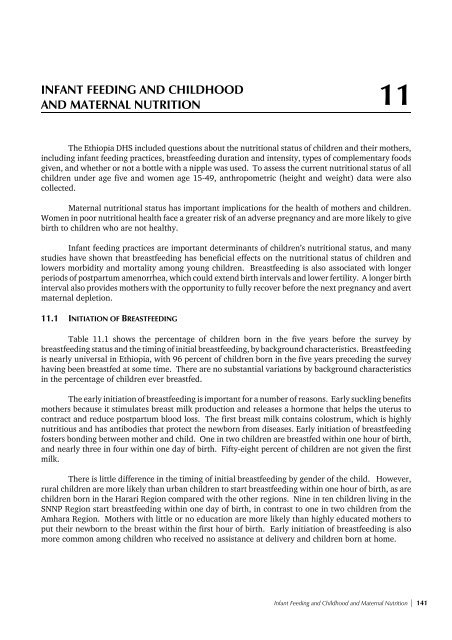PDF, 1536K - Measure DHS
PDF, 1536K - Measure DHS
PDF, 1536K - Measure DHS
You also want an ePaper? Increase the reach of your titles
YUMPU automatically turns print PDFs into web optimized ePapers that Google loves.
INFANT FEEDING AND CHILDHOOD<br />
AND MATERNAL NUTRITION<br />
11<br />
The Ethiopia <strong>DHS</strong> included questions about the nutritional status of children and their mothers,<br />
including infant feeding practices, breastfeeding duration and intensity, types of complementary foods<br />
given, and whether or not a bottle with a nipple was used. To assess the current nutritional status of all<br />
children under age five and women age 15-49, anthropometric (height and weight) data were also<br />
collected.<br />
Maternal nutritional status has important implications for the health of mothers and children.<br />
Women in poor nutritional health face a greater risk of an adverse pregnancy and are more likely to give<br />
birth to children who are not healthy.<br />
Infant feeding practices are important determinants of children’s nutritional status, and many<br />
studies have shown that breastfeeding has beneficial effects on the nutritional status of children and<br />
lowers morbidity and mortality among young children. Breastfeeding is also associated with longer<br />
periods of postpartum amenorrhea, which could extend birth intervals and lower fertility. A longer birth<br />
interval also provides mothers with the opportunity to fully recover before the next pregnancy and avert<br />
maternal depletion.<br />
11.1 INITIATION OF BREASTFEEDING<br />
Table 11.1 shows the percentage of children born in the five years before the survey by<br />
breastfeeding status and the timing of initial breastfeeding, by background characteristics. Breastfeeding<br />
is nearly universal in Ethiopia, with 96 percent of children born in the five years preceding the survey<br />
having been breastfed at some time. There are no substantial variations by background characteristics<br />
in the percentage of children ever breastfed.<br />
The early initiation of breastfeeding is important for a number of reasons. Early suckling benefits<br />
mothers because it stimulates breast milk production and releases a hormone that helps the uterus to<br />
contract and reduce postpartum blood loss. The first breast milk contains colostrum, which is highly<br />
nutritious and has antibodies that protect the newborn from diseases. Early initiation of breastfeeding<br />
fosters bonding between mother and child. One in two children are breastfed within one hour of birth,<br />
and nearly three in four within one day of birth. Fifty-eight percent of children are not given the first<br />
milk.<br />
There is little difference in the timing of initial breastfeeding by gender of the child. However,<br />
rural children are more likely than urban children to start breastfeeding within one hour of birth, as are<br />
children born in the Harari Region compared with the other regions. Nine in ten children living in the<br />
SNNP Region start breastfeeding within one day of birth, in contrast to one in two children from the<br />
Amhara Region. Mothers with little or no education are more likely than highly educated mothers to<br />
put their newborn to the breast within the first hour of birth. Early initiation of breastfeeding is also<br />
more common among children who received no assistance at delivery and children born at home.<br />
Infant Feeding and Childhood and Maternal Nutrition * 141








![Obtaining Informed Consent for HIV Testing [QRS4] - Measure DHS](https://img.yumpu.com/49850117/1/190x245/obtaining-informed-consent-for-hiv-testing-qrs4-measure-dhs.jpg?quality=85)








